Michael Pollan’s Food Rules is very simple, very straight-forward. I liked it. But am I breaking a lot of the rules? Sure. Am I following a lot? Yeah.
Let’s take a moment and judge the heck out of my kitchen. Just kidding, don’t. Because right about now I feel like the biggest wannabe foodie ever. Let’s be real. “Foodies” don’t have sugar-free popsicles in their freezer. They have like fancy gelato or ice cream from the farmers market. I’m slightly ashamed. But, that’s why I wanted to do this blog, because I want to try harder to eat healthier and more local, and inspire others to do the same.
So, I took out all the food (minus farmers market foods) from my cabinets and my fridge and laid it all out on the counter top. I then tried to arrange it from “best” to “worst.” It ended up being a far more complicated challenge than I had anticipated.
Seriously, not easy.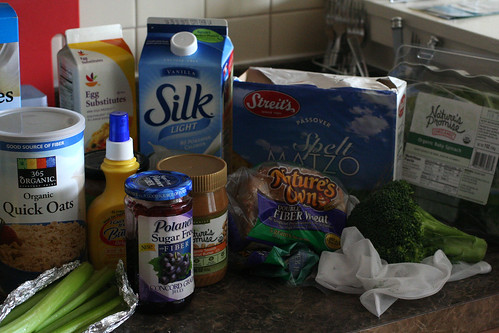
Of course, I had to first ask myself, what defines “best” when it comes to food? Does this mean the tastiest? The healthiest? What defines “healthy“? Low in cholesterol? Low in sugar? High in fiber? Organic? Highest in vitamins and minerals? The least processed? The best combination of all of these things? There is actually a company, Nuval, that does just this, rating foods on a scale of one to 100, with 100 being the most healthy. But that doesn’t take ‘localness’ into account, nor the manner in which the food was grown/raised/caught and whether it was sustainable.
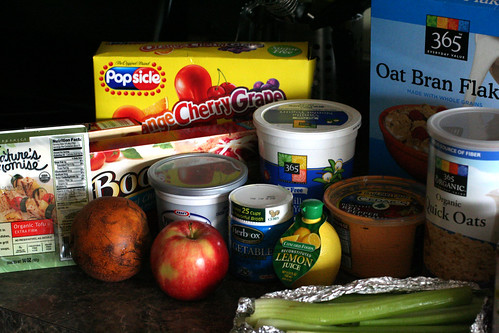 Or, does ‘best’ mean just that: the most local/sustainable? I mean, is it better to eat an organic apple that was shipped from Washington state if I live in Washington, DC–or is it better to eat a genetically modified apple grown in Virgina? (Though I suppose it would be best to eat an organic apple grown on a small farm in Virgina.)
Or, does ‘best’ mean just that: the most local/sustainable? I mean, is it better to eat an organic apple that was shipped from Washington state if I live in Washington, DC–or is it better to eat a genetically modified apple grown in Virgina? (Though I suppose it would be best to eat an organic apple grown on a small farm in Virgina.)
And what about people with food allergies or high blood pressure, or diabetes? What about vegans and people with strict diets they adhere to for their health, well being, or moral/religious beliefs? They would rank all of these foods completely differently based on their inability/desire to eat certain ingredients. We, as eaters, have so many conflicting needs, desires, availabilities–that it’s no wonder no one knows what to eat ever, or just doesn’t care or think about it much anymore. It’s no wonder our eating dilemma, as omnivores in an unstable world of mixed messages, marketing, and frankenfoods, is such a–well, dilemma.
I quickly gave up on trying to rank my foods. It seemed like a lost cause, and maybe a useless endeavor after all.
Instead, I started making a list of descriptions and ingredients listed on the foods, which was chaotic in its own right, just to get a sense of what we’re dealing with here. I discovered my fridge and pantry are breaking a whole lot of Michael Pollan’s Food Rules:
- 1/10 of 1% sodium benzoate & potassium sorbate (too much math for me)
- No high fructose corn syrup
- USDA organic (ahh, the complexities of this alone could have volumes written on it)
- All-natural
- No artificial colors, flavors or preservatives
- Magnesium chloride
- from Southeast Australia, “Enjoy it on a warm summer’s evening” (wait, so does that mean I should enjoy it on Australian time, because when it’s summer there, it’s cold here…) Though, I am doing well on Rule #43 – Have a glass of wine with dinner
- Reconstituted (Definitely had to google this one…)
- Sugar-free (meaning splenda/aspartame used instead)
- Fat-free (meaning, the fat was replaced with sugar — Also in violation of Food Rule #9 – Avoid food products with the wordoid “lite,” or the terms “low-fat,” or nonfat in their names.
- Made with milk from cows not treated with rBGH
- “Sensible Solution”
- Good manufacturing practices used to segregate ingredients in a facility that also processes milk/egg ingredients (OK, really? What is someone with a dairy allergy meant to make of this one? Is it safe? Not safe?)
Now, I consider myself a fairly “aware” and generally healthy eater. But I can tell you I still feel like I know almost nothing about what I eat. I don’t know what probably half of the aforementioned words and phrases mean, and even when I do, I don’t know what they mean for my health. And even if I know what they mean for my health, I still feel like there’s an untold side to every story. All of the items I have pictured here were bought either at Whole Foods or Giant, none at the farmers market, which to me means I have no idea about their origins, ingredients, and implications for my health. Furthermore, a lot of the food I eat I know isn’t great for me, but I justify eating it because it has other “side benefits.”
Case in point: my “I Can’t Believe It’s Not Butter” Spray. Now, I know it’s made  entirely of chemicals and artificiality, but I somehow justify it just like I justify the occasional packet of Sweet-n-low and other sugar alternatives. Both spray butter and regular butter aren’t great for you, but perhaps in moderation, neither are dangerous. I somehow feel better knowing I didn’t just spread 7g of saturated fat and 30mg of cholesterol on my toast (high cholesterol runs in my family), but instead sprayed it with potassium sorbate, xantham gum, and polysorbate 60. Definitely in violation of Rule #7 – Avoid food products containing ingredients that a third-grader cannot pronounce.
entirely of chemicals and artificiality, but I somehow justify it just like I justify the occasional packet of Sweet-n-low and other sugar alternatives. Both spray butter and regular butter aren’t great for you, but perhaps in moderation, neither are dangerous. I somehow feel better knowing I didn’t just spread 7g of saturated fat and 30mg of cholesterol on my toast (high cholesterol runs in my family), but instead sprayed it with potassium sorbate, xantham gum, and polysorbate 60. Definitely in violation of Rule #7 – Avoid food products containing ingredients that a third-grader cannot pronounce.
Ranking aside, I did decide to go ahead and pick out what I deemed to be the “A+” and the “F-” of my kitchen (of the grocery store-bought items).
A+ goes to…the Nature’s Promise Peanut Butter.
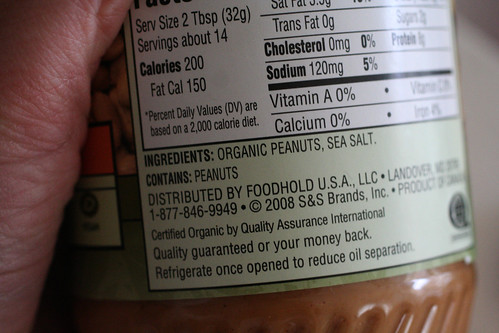 Now, I gave this the gold because when I took these pictures I was out of almond butter–or else that would have been the clear winner. Anyway, this is a close second, with two ingredients on the label, organic peanuts and sea salt. It says it was distributed in Maryland, but I have no idea if this is where the peanuts came from, so “local” scores a little low. However, I give this product props because it’s not all that much more expensive than the Skippy stuff, and it tastes a million times better, (like real peanuts–go figure.) If I could somehow find out where the peanuts were from and it wasn’t too far, I could feel really good about this peanut butter. Definitely passes #14 – Eat foods made from ingredients you can picture in their raw state or growing in nature. And I got it at Giant!
Now, I gave this the gold because when I took these pictures I was out of almond butter–or else that would have been the clear winner. Anyway, this is a close second, with two ingredients on the label, organic peanuts and sea salt. It says it was distributed in Maryland, but I have no idea if this is where the peanuts came from, so “local” scores a little low. However, I give this product props because it’s not all that much more expensive than the Skippy stuff, and it tastes a million times better, (like real peanuts–go figure.) If I could somehow find out where the peanuts were from and it wasn’t too far, I could feel really good about this peanut butter. Definitely passes #14 – Eat foods made from ingredients you can picture in their raw state or growing in nature. And I got it at Giant!
Next up gets the award for the shadiest food product, a definite F-…Herbox Vegetable Bouillon Cubes
Can I just say that I used to survive off of these? I used to dunk them into steaming mugs of water in my dorm room and eat the “soup” that was produced with saltines I stole from TDR dining hall when I was a freshman in college. Yeah, super nutritious. Now, little did I know that I was purchasing a product made with CHICKEN at the time. I didn’t even know it was made with 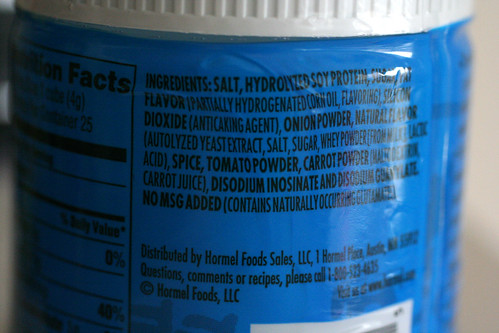 “chicken” when I bought it at the store the other day. OK. So if we are this company, “Herbox”and we make beef, chicken, and veggie bouillon cubes, wouldn’t you think we would keep the beef and the chicken OUT of the veggie one–that being the only reason people would buy it–because it’s meat-free? If I buy vegetable bouillon cubes, I expect them to be vegetarian!! If I didn’t mind chicken in my boullion, don’t you think I would just just buy the chicken kind? GRR.
“chicken” when I bought it at the store the other day. OK. So if we are this company, “Herbox”and we make beef, chicken, and veggie bouillon cubes, wouldn’t you think we would keep the beef and the chicken OUT of the veggie one–that being the only reason people would buy it–because it’s meat-free? If I buy vegetable bouillon cubes, I expect them to be vegetarian!! If I didn’t mind chicken in my boullion, don’t you think I would just just buy the chicken kind? GRR.

Well, I checked out the 20+ ingredient list of these babies and still didn’t see anything about chicken. So unless “fat flavor” means “chicken fat flavor”–I am at a loss. (By the way, how do you grow chicken fat flavor?) Furthermore, these little cubes violate Pollan’s Rule #3 – Avoid food products containing ingredients that no ordinary human would keep in the pantry.

Speaking of chicken, here is one item I wasn’t sure about how to grade…my fake chicken patties. Now, I don’t u
sually buy these, if I am being totally honest, but for whatever reason, I had a coupon or whatever, so I bought them the other day. On the one hand, they are an alternative to real chicken, meaning I am avoiding contributing to all of the awful chicken factory farming and am avoiding meat littered with antibiotics. However, this boca burger has more ingredients in it than the veggie bouillon! And if I were going by Pollan’s Rule #10 – Avoid foods pretending to be something that they are not.– The fake chicken patties would definitely be out.
Who has time to think about all of this though? Well, we all should, and we all do have time. But we spend that time thinking about things that ultimately have so much less of an impact on our personal well being and future generations’ well being. For God sakes, I recently spent months deliberating what kind of new cell phone I was going to purchase next. And we don’t put cell phones inside of our bodies! (Hopefully.)
In a future post, I think I will look more specifically at this “natural versus organic” thing. See if I can straighten out all those question marks. I think I’ll also look at where our priorities should lie, as omnivores.
A couple food rules I am following well:
#25 Eat your colors.
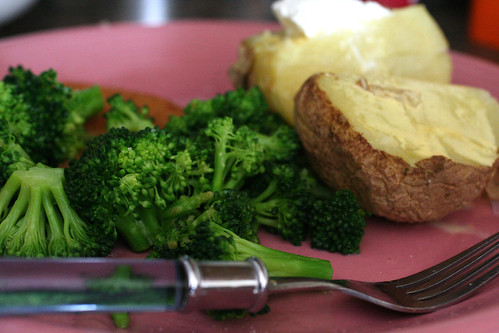 #55 – Eat meals.
#55 – Eat meals.
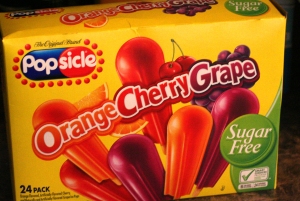 …and #64 – Break the rules once in a while.
…and #64 – Break the rules once in a while.
No comments:
Post a Comment